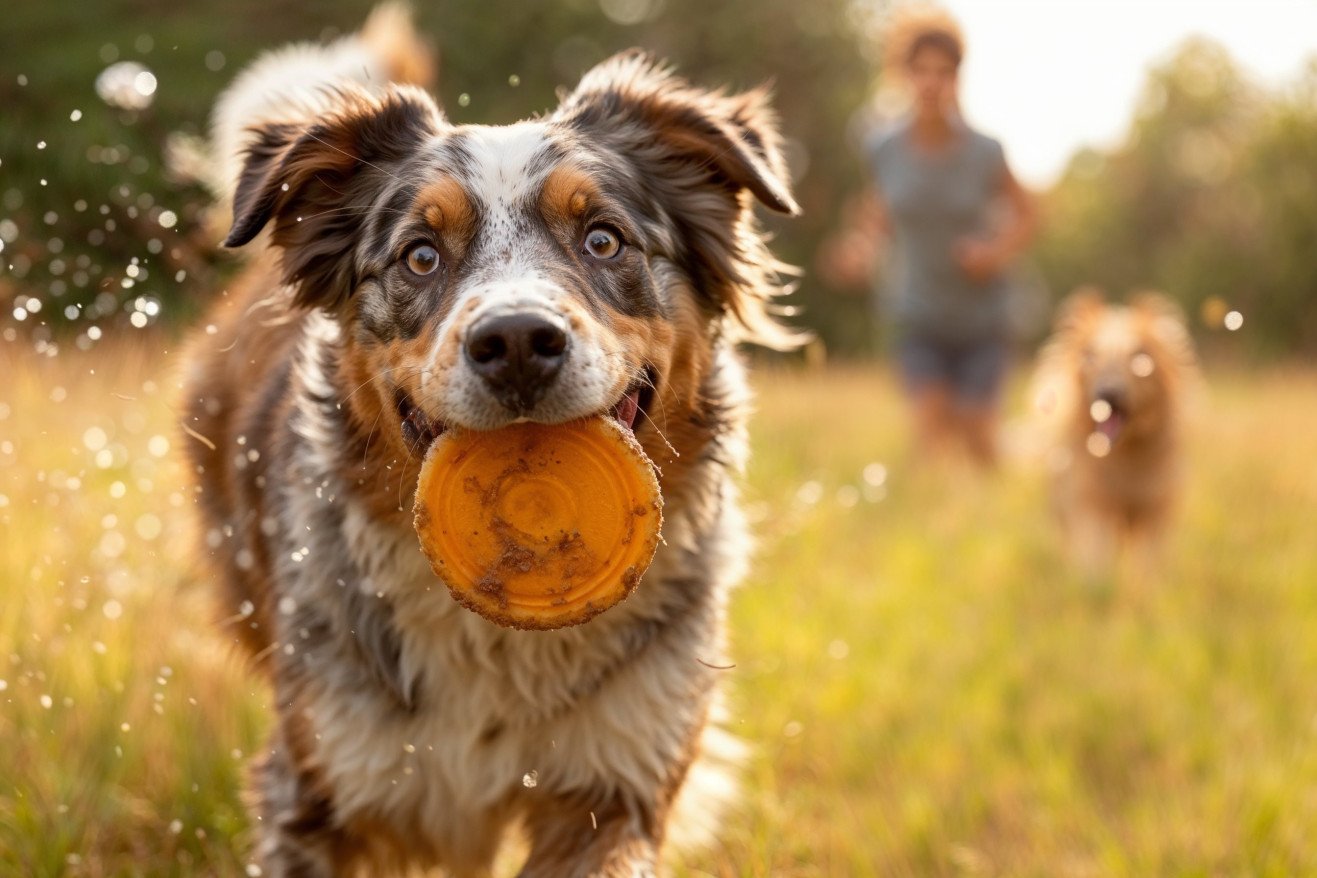How Much Exercise Does Your Dog Need? A complete Guide
29 January 2024 • Updated 30 January 2024

Finding the right amount of exercise for your dog is a mix of science and intuition. In general, dogs need between 30 minutes and 2 hours of exercise each day. Smaller dogs and senior dogs may need less, while more active and working dogs may need more. Make sure to adjust your dog’s exercise based on their age, health, and breed, and always ask your vet for personalized recommendations.
To help us get a better idea, we’ll look at veterinary advice and animal exercise physiology studies to determine the best exercise plans for dogs. We’ll look at the exercise needs of different breeds, life stages, and health conditions to create a complete guide that will help you make sure your dog is getting the right amount of exercise to support their physical and mental health.
By the end of this guide, you’ll have the information you need to make the best choices for your dog’s daily exercise.
What factors are most important in determining the amount of exercise a dog needs?
How to Customize Exercise for Your Dog’s Breed, Age, and Health
When it comes to your dog’s daily exercise, it’s important to remember that not all dogs are created equal. Orvis News explains that the exercise requirements for dogs can vary widely based on their breed. For example, high-energy breeds like Labrador Retrievers and German Shepherds may need more than an hour of exercise a day, while smaller or less active breeds may need much less.
Just like human athletes, your dog’s breed can determine the type and amount of exercise that will be most beneficial.
Your dog’s age is another important factor in how much exercise they need. Puppies, who are often full of seemingly endless energy, need exercise in short, controlled bursts, while adult dogs need regular exercise to stay healthy. Meanwhile, senior dogs still need daily exercise, but the amount and intensity should be adjusted to make sure they’re comfortable, according to Small Door Veterinary.
Your dog’s health is also an important factor to consider when determining how much exercise they need. The American Kennel Club explains that if your dog has certain health issues, like hip dysplasia or heart problems, you may need to adjust their exercise routine. A vet can help you make sure that the exercise plan you create for your dog is not only tailored to their needs but also effective and safe.
By taking these factors \—breed, age, and health—into account, you can create an exercise plan that will help your dog stay healthy. However, keep in mind that a vet can give you the most personalized advice to make sure your dog stays healthy, happy, and ready for their next adventure.
Fueling Fido: How Nutrition Fits Into Your Dog’s Exercise Routine
A well-balanced diet is essential for providing your dog with the energy they need to exercise, and protein and fat are the most important macronutrients for active dogs.
According to Animal Wellness Magazine, active dogs should be fed a diet that is higher in these macronutrients, and Essence formulas recommends a minimum of 35% protein and 17% fat to meet the needs of active dogs.
In addition to providing the right macronutrients, the right diet will also provide the right number of calories to help your dog maintain their energy levels and improve their performance. This is especially important for performance dogs, as VCA Animal Hospitals explains that these dogs can participate in everything from sprinting to endurance sports, and they need to be fed a diet that will help them keep up with the number of calories they burn.
In addition to making sure your dog is getting the right amount of calories, it’s also important to make sure they are getting enough water. Dogs need water to help them regulate their body temperature and maintain healthy tissues while they are exercising.
Make sure your dog has access to water before, during, and after exercise to help them stay healthy. Melrose Vet also notes that it’s important to make sure your dog is eating at the right times—they recommend feeding your dog at least two hours before they are going to be exercising and waiting at least an hour after they have exercised to feed them again to make sure they have time to rehydrate and cool down.
Your dog’s diet should also change based on the intensity and duration of their exercise. Make sure you are regularly evaluating and adjusting your dog’s diet to make sure they are getting the right amount of food to support their activity level.
How to Tell If Your Dog Is Over-Exercising
While exercise is important, especially for high-energy breeds, over-exercising can lead to a number of issues. Dogs can experience joint, back, and respiratory injuries, as well as heat-related illnesses due to over-exercising.
Waggle lists common signs of over-exercising in dogs, including muscle soreness, stiffness, lethargy, weakness, loss of appetite, and changes in mood or behavior. Meanwhile, PetMD lists symptoms like worn paw pads, sore muscles, and, in extreme cases, heatstroke, which can be fatal and occurs when a dog’s body temperature rises above 106 degrees Fahrenheit.
If you think your dog is over-exercised, it’s important to modify their exercise routine. This may mean shorter walks, less intense play, or more days of rest. Recovery is just as important as the exercise itself, as it allows your dog’s body to heal and grow stronger. According to PitPat, it’s important to watch your dog for any signs of concern after exercise, such as heavy panting, labored breathing, or a reluctance to move.
By carefully and thoughtfully tending to your dog’s exercise needs, you can make sure that their routine is helping them stay healthy without pushing them too hard. Paying attention to your dog’s behavior after exercise will help you understand their health and take a balanced approach to their physical activity.
Tapping Into the Mental Health Benefits of Dog Exercise
The mental health benefits of exercise for dogs are extensive and wide-ranging. In addition to better behavior and lower stress levels, which can lead to a happier home life, dogs experience a release of endorphins and endocannabinoids, which are often referred to as a “runner’s high,” that help them feel better and reduce pain, according to a study cited by PetHelpful.
Exercise is also important for maintaining cognitive health and promoting brain health. According to the AKC, exercise in dogs leads to the release of brain-derived neurotrophic factor (BDNF), which helps the brain grow new cells, especially in the hippocampus, which is the part of the brain that’s responsible for learning and memory.
When dog owners add mentally stimulating exercises, such as interactive games, puzzle toys, and scent work, to their dogs’ exercise routines, they can help improve their dogs’ mental sharpness. These exercises not only help keep dogs’ minds sharp, but they also help improve the bond between dogs and their owners because shared experiences and accomplishments can help build trust and affection.
By making sure your dogs get both physical and mental exercise, you can help ensure that they’re healthy and happy.
In Conclusion: How to Get Your Dog to a Healthy, Happy Place
As we’ve seen, the exercise requirements of our dogs are just as diverse as their breeds, ages, and health issues. While a high-energy breed like the Labrador Retriever may need a lot of exercise every day, a small dog like the Chihuahua may be happy with indoor play and a couple of short walks.
That means that every dog’s exercise routine needs to be tailored to their individual needs. It’s also important to make sure that every dog’s exercise routine includes mental stimulation, and that you think about low-impact exercises for older dogs and dogs with health issues.
It’s also important to make sure that you’re always monitoring and adjusting your dog’s exercise routine. Make sure that you’re watching for signs that your dog isn’t getting enough exercise, like restlessness, and that you’re also watching for signs that your dog is getting too much exercise, like fatigue and injury.
Regular exercise is important for maintaining physical health and mental well-being, and it can help reduce stress and strengthen the bond between dogs and their owners.
So, in the end, by taking a proactive approach to your dog’s health and making sure that their exercise routine is tailored to their needs, you can make sure that you and your dog enjoy all the benefits of a healthy, active, and engaged pet. Enjoy the process of finding the right balance, and enjoy all the happy moments of exercise that you and your loyal companion share.


